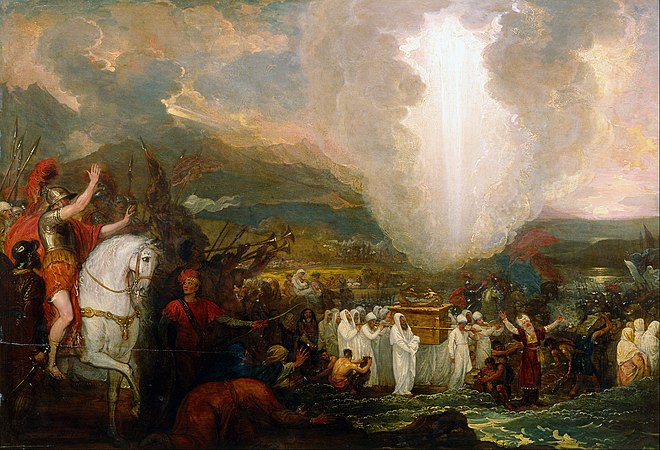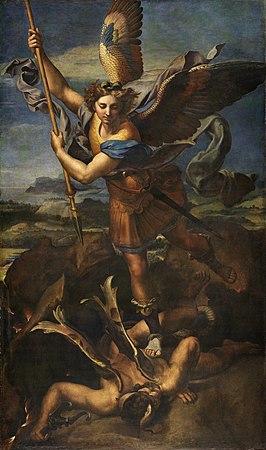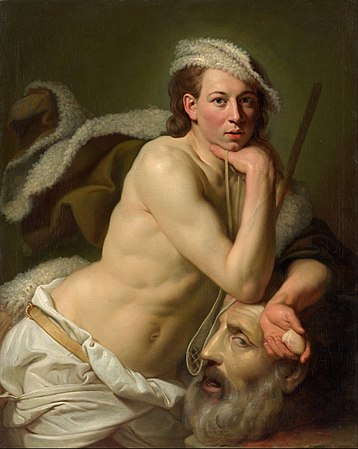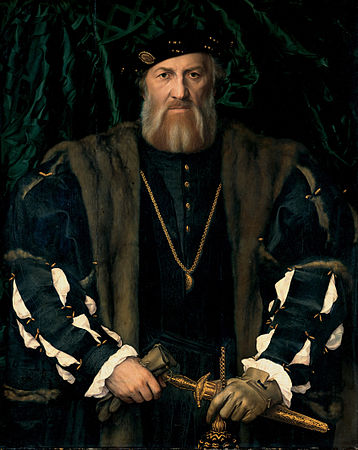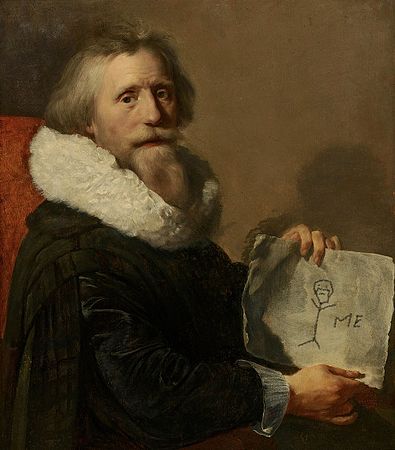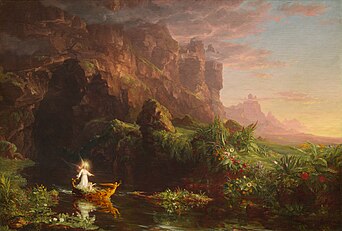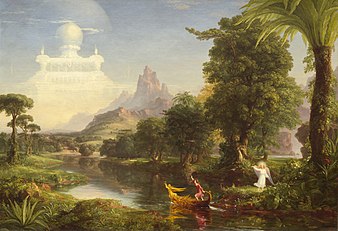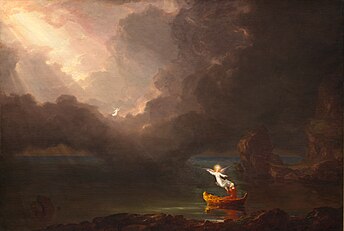Wikipedia:Wikipedia Signpost/Single/2014-11-19
To Canaan via Jordan
-
St. Michael Vanquishing Satan by Raphael.
Featured articles
Two featured articles were promoted this week.

- Masked shrike (nominated by Jimfbleak) is a bird in the shrike family, Laniidae. The male has mainly black upperparts, with white on its crown, forehead and supercilium and large white patches on the shoulders and wings. The throat, neck sides and underparts are white, with orange flanks and breast, hence named as masked.
- Luo Yixiu (nominated by Midnightblueowl) was the first wife of the future Chinese communist revolutionary and political leader Mao Zedong. She was eighteen and Mao just fourteen years old at the time of their betrothal. Mao later stated that he was unhappy with the marriage, never consummating it and refusing to live with his wife anymore and it was this experience with Luo that turned Mao into a "fierce opponent" of arranged marriage.
-
Johan Zoffany's Self-portrait as David with the head of Goliath
-
Hans Holbein the Younger's painting of French soldier Charles de Solier. Is that a dagger in your pocket, or are you... oh, right, it is a dagger. Never mind.
Featured lists
Five featured lists were promoted this week.

- Sandra Bullock filmography (nominated by Cowlibob) In 2013, Sandra Bullock starred in the megahit, seven-Oscar-winning Gravity (which I haven't seen) and the slightly less successful The Heat (which I haven't seen). But her career dates back to 1987, and includes several highly popular movies, such as Demolition Man (which I haven't seen), Infamous (which I haven't seen), and The Blind Side (which I haven't seen), as well as the occasional forgettable movie as Love Potion No. 9 (which I have seen). Okay, I also saw Speed, but that doesn't fit the running gag.
- Mayor of San Diego (nominated by mcd51) From the time of California's statehood in 1850 (the situation before then is a bit more complicated), San Diego has had thirty-five mayors, eight acting mayors, and one period from 1852 to 1888 under a Board of Trustees after a bankruptcy.
- List of works by John Buchan (nominated by SchroCat) Probably best known for his thriller novel The Thirty-Nine Steps, John Buchan was a Scottish novelist, historian, and biographer, who wrote twenty-nine novels in total, and fourty-two books of non-fiction.
- List of church ruins on Gotland (nominated by Yakikaki) The island of Gotland is Sweden's largest island. Converted to Christianity in the 11th century, it is dotted with the ruins of nineteen churches. Many churches were built from the 12th to 15th centuries, but between the Black Death, an invasion by Denmark, pillaging, and the Reformation, the economic and social reasons for the churches eventually vanished, with every church in the main town of Visby except for Visby Cathedral allowed to fall into decay from the early 16th century to the first attempts to protect the ruins in the 19th century.
- List of accolades received by The Avengers (2012 film) (nominated by TriiipleThreat) Making back over six times its budget, Avengers Assemble - called The Avengers if you don't have a famous television series with Emma Peel in your country - is a massive, worldwide phenomenon, that we would certainly be raving about in this issue of The Signpost had I actually seen any of the films. So... Um... The film was nominated for an Academy Award, but lost out to The Life of Pi (another film I haven't seen!). I'm going to stop talking now.
-
This self-portrait of Paulus Moreelse is gorgeously done, but why is he holding a blank piece of paper?
-
Perhaps we can improve things by acting as if we're five?
Put your own suggestions in the comments, but remember: Everything you use has to be free licensed and properly credited, or your own work.
Featured pictures
Twenty-six featured pictures were promoted this week.






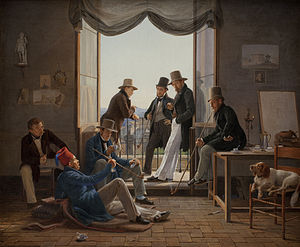
- Mysore Palace (created and nominated by Muhammad Mahdi Karim) depicting the front facade of the Mysore Palace in a morning. The Palace of Mysore is the official residence and seat of the Maharajas of Mysore, a historical palace in the city of Mysore in Karnataka, southern India, commonly described as the City of Palaces. It is the official residence and seat of the Wodeyars — the former royal family of Mysore, who ruled the state of Mysore from 1399 to 1950. The palace houses two ceremonial meeting halls of the royal court and incorporates a huge number of courtyards, gardens, and buildings. Can you see the stray dogs playing and resting in front of the palace? They are protected in India.
- Cairn in Snow (created by Caspar David Friedrich, nominated by Hafspajen) is a 1807 canvas painting by Caspar David Friedrich. The painting is a Romantic allegorical landscape, showing a pagan burial site between three oaks, near the town Gützkow in Germany. Together with the Romantic painters, Caspar David Friedrich developed the landscape painting into a major genre within Western art. Friedrich was one of the first artists who painted lonely winter landscapes. The painter depicts barren trees in the snow, giving the work a haunted, spectral air.
- Robert E. Lee (created by Levin C. Handy, nominated by Adam Cuerden) was an American soldier best known for commanding the Confederate Army of Northern Virginia in the American Civil War.
- Freedom Monument (created by Poco a poco, nominated by Yakikaki) The Freedom Monument in Riga, Latvia commemorates the soldiers killed in the Latvian War of Independence (1918-1920) at the end of World War I. When the Soviets took Latvia over in 1940, the monument was considered for demolition, but was not, possibly due to Soviet sculptor Vera Mukhina's intervention on behalf of the monument's artistic merit. And here I have to quote the article, as this is such a wonderful example of Soviet Russian rewriting of history:
| “ | The Freedom Monument remained, but its symbolism was reinterpreted. The three stars [held by the statue of Liberty on the top of the monument] were said to stand for the newly created Baltic Soviet Republics – Estonian SSR, Latvian SSR, and Lithuanian SSR – held aloft by Mother Russia, and the monument was said to have been erected after World War II as a sign of popular gratitude toward the Soviet leader Joseph Stalin for the liberation of the Baltic States. | ” |
- Joshua passing the River Jordan with the Ark of the Covenant (created by Benjamin West, nominated by Hafspajen) According to Jewish and Christian scriptures, after the death of Moses, Joshua took over command of the Israelites, and led them towards the Promised Land. A Pillar of Cloud by day (shown) and Pillar of Fire by night guided them. The Ark of the Covenant - a chest containing containing the Tablets of Stone on which the Ten Commandments were inscribed was carried along with them, carefully concealed. The River Jordan marked the boundaries of the Promised Land - and it is this, a view of the Israelites at the border of the Promised Land, after forty years wandering the desert, that Benjamin West paints here. When the Ark with golden staves adorned with golden cherubims was borne into the bed of the Jordan River, the waters parted, opening a pathway for the entire host to pass through.
- Portrait of a Carthusian (created by Petrus Christus, nominated by Chris Woodrich) Possibly a portrait of Denis the Carthusian, a mystic and contemplative whose article could really use a copyedit, Petrus Christus' Portrait of a Carthusian is a masterpiece of Early Netherlandish painting. The innovative lighting scheme and positioning produced a portrait that, for the early fifteenth century, shows a mastery of depth and perception, and creates a realistic three-dimensional head. This painting is not only an incisive psychological portrait but also a prominent, early example of Trompe l’oeil. Trompe l’oeil paintings - (French for Trick the eye) are paintings contrived to create optical illusions - giving the impression that the depicted objects actually exist in three dimensions. The frame in the picture is not real, it is painted, and so is the fly, painted on the frame.
- The Sisters (Eleanor and Rosalba Peale) (created by Rembrandt Peale, nominated by CorinneSD) The Peale family were a noted family of artists; this painting by Rembrandt Peale shows his sisters Eleanor and Rosalba. Given the number of major, independently famous artists, both male and female, in that family - we've featured a few of them already - the real surprise here is that Rosalba and Eleanor apparently aren't incredibly important to the history of American art.
- European robin (created and nominated by Francis Franklin) The robin is a familiar bird in Europe, originally named "redbreast", as the word orange entered the language with the fruit. During a period when birds were being personified by being given first names, "redbreast" became "Robin Redbreast", and eventually shortened to "robin". The American robin is an unrelated species, named due to a vague similarity in the colouration of its chest.
- Self-portrait of Paulus Moreelse (created by Paulus Moreelse, nominated by Chris Woodrich) A fine c. 1630 self-portrait of Dutch Golden Age painter Paulus Moreelse holding a much tempting empty paper in his hands (1571–1638). Some fall for the temptation... There are many different files by now of this picture, some worse than others. Although Paulus Moreelse is known for his... interesting portraits of young ladies, perhaps some of the artworks might have shocked even him?
- Self-portrait as David with the head of Goliath (created by Johann Zoffany, nominated by Adam Cuerden) Johann Zoffany was a 18th- to 19th-century German painter active primarily in England. Zoffany was a founding member of the Royal Academy of Arts, and was a very unique artist. He was very popular both for his exquisite society paintings and theatrical portraits, depicting many of the prominent actors and actresses of his time, including the much celebrated David Garrick. Since Zoffany worked heavily in theatrical portraits, painting so many actors in costume, it's probably not surprising that he was attracted to a far more striking and interesting self-portrait than your average artist.
- Sorrow (created by Vincent van Gogh, nominated by Chris Woodrich) An 1882 drawing by Vincent van Gogh early in his artistic career, Sorrow is considered the culmination of van Gogh's apprenticeship to the craft, showing a naked woman (modelled by Sien Hoornik) in a desolate landscape, burying her face in her crossed arms, which set on her knees. Sadness and sorrows are also part of life and of Wikipedia too, sometimes...
- Dovedale by Moonlight (created by Joseph Wright of Derby, nominated by Hafspajen) Set in Dovedale, a picturesque valley (or dale) in the Peak District of Staffordshire, England, Dovedale by Moonlight was painted by someone who had never actually been to the vale at night, but was good enough of an artist to still do an excellent painting. Joseph Wright of Derby was a very interesting English painter, both a good landscape and portrait painter, but also famous for his paintings associated with the British Enlightenment.
- St. Michael Vanquishing Satan (created by Raphael, nominated by Chris Woodrich) Showing a scene from the Book of Revelation, St. Michael Vanquishing Satan shows the archangel Saint Michael hovering over Satan, his spear about to strike home. Michael symbolizes the victory of good over evil, and he has been widely represented in art through the ages, as the leader of the Army of Angels. The remains of the fallen angel Satan's wings, ravaged from his fall from heaven, stick up from his back.
| “ | "Who is like God?" was the cry of Archangel Michael when he smote the rebel Lucifer in the conflict of the heavenly hosts. And when Antichrist shall have set up his kingdom on earth, it is St Michael who will unfurl once more the standard of the cross, sound the last trumpet, bind together the false prophet and the beast and hurl them for all eternity into the burning pool. | ” |
- Nativity (created by Petrus Christus, nominated by Adam Cuerden) The article's just been promoted to featured article, so watch this space in two weeks, when the new featured article will be highly seasonal, and we can showcase this wonderful painting properly. In the meantime, just have a look at all the wonderful details - the tiny angels, the archway, the way that the painting zooms through a church-like archway through a stable and deeper still to fields, a city, and mountains. It's beautifully composed.
- The Voyage of Life: Childhood, Youth, Manhood, and Old Age (created by Thomas Cole, nominated by Chris Woodrich) A Christian allegory of four stages of human life, The Voyage of Life consists of four paintings, each showing a ship sailing, the mariner accompanied by a guardian angel. First, the child emerges from a dark cave, then the youth takes control, and tries to get to a shining castle. Rough waters are met by prayers in adulthood, and, finally, the angel leads the ship to the waters of eternity.
- View from the Artist's Window (created by Martinus Rørbye, nominated by Hafspajen) The surprising thing about Martinus Rørbye's View from the Artist's Window was the unexpected connection to historical events: behind the decorations of the window, ships being constructed can be seen. Given the date, these ships are almost certainly the ones being constructed to replace those lost in the Battle of Copenhagen (1807), in which the British forces ravaged the Danish fleet. Like most paintings of the Romantic era, the painting has many underlying symbolic meanings: The window opens towards the light, the ships in the harbour symbolize the longing for an unknown calling, and the cage with the imprisoned bird symbolizes the old home as a prison for the artist longing to explore the world outside. On the windowsill, potted plants symbolize the different stages of growth of human life, and a blank sketchbook is waiting to be filled.
- A Group of Danish Artists in Rome (created by Constantin Hansen, nominated by Hafspajen) The Danish Golden Age painters are gathered in Rome in a little room. This is the generation before the Skagen Painters - the Golden Age of Danish Painting was the first national style of Denmark. The first half of the 19th century in Denmark started with an explosion of gorgeous artworks out of Denmark, landscape paintings, portraits and scenes lighted by the special northern light that is soft, but allows strong contrasts of colour. This painting shows some of the important artists of the period: Architect Michael Gottlieb Bindesbøll is lying on the floor with a fez and pipe, Martinus Rørbye is sitting on the floor, beside, looking somewhat critical into his tiny coffee cup. Constantin Hansen (who painted it), is sitting behind them in the other chair. Wilhelm Marstrand, Albert Küchler, Ditlev Blunck are on the balcony and Jørgen Sonne is sitting on the table. The dog sitting on the chair, however, is not known to have created any important works.
- Christmas truce (created by A. C. Michael for The Illustrated London News, nominated by Adam Cuerden) Christmas is coming. That's where all the snow comes from. Christmas is a time of good will and cheer, and even in the middle of World War I, soldiers from both sides, sporadically, at different places down the line, stopped fighting, met in the neutral territory, talked, took photos, shared food and gifts, sang carols, and, although the prevalence and amount of organization is probably exaggerated, played football with each other.
- Nuremberg, Pennsylvania (created and nominated by Jakob) A photograph of the beautiful small town of Nuremberg, in eastern Pennsylvania, showing the autumnal colours of the American northeast. It's a gorgeous photograph, and really adds to the (admittedly fairly short) article.
- Newsagent's shop (created by Florian Plag, nominated by Crisco 1492) A newsagent's shop in Paris, selling postcards, newspapers, magazines, books, maps, and what appear to be DVDs. Newsstands are business that sells beside newspapers and magazines, also cigarettes, snacks and items of local interest, typically operating in busy public places like city streets, railway stations and airports. Racks for newspapers and magazines can also be found in convenience stores, bookstores and supermarkets.
- Theodor Heuss Bridge (created by Arcalino, nominated by Jim Carter) Dating from 1948-50, but part of a series of bridges dating back to the Romans in 27 AD. The Theodor Heuss Bridge is a deck arch bridge across the Rhine River that connects two cities in in Germany - namely Mainz and Wiesbaden. The very first bridge over the water was a pontoon bridge, but, in about the year 27 AD, a fixed bridge was constructed, consisting of at least 21 stone pillars of 18 meters long and 7 meters wide and 12 meters wide, with a multi-lane roadway. The remains of this Roman bridge over the Rhine, which stood above the present Theodor Heuss Bridge, are an evidence of the high engineering art of the Romans. The reconstruction of the bridge was completed in 1950.
- Madonna of the Book (created by Sandro Botticelli, nominated by User:Hafspajen) Perhaps best known for his The Birth of Venus (Botticelli), Sandro Botticelli was a fifteenth- and early-sixteenth-century Italian painter. His Madonna of the Book shows the Virgin Mary concentrating on a Book of Hours - a collection of prayers - while the infant Jesus in her arms gazes at her lovingly. Botticelli painted the scene with sensitivity and love of details, that are depicted almost as a still life; the pages of the book, the garments, the transparent veils—they all have an amazing tactile quality. The details have symbolic meaning, as they often had with old masters; the fruit on the plate has an emblematic meaning, with the cherry representing either the blood of Christ or an allusion to Paradise, the plum indicating the tenderness between Mary and the Child, and the fig characteristic of the Resurrection. The window opens up towards a distant landscape, but the soft light seems to emanate from the figures themselves.
- Charles de Solier, comte de Morette (created by Hans Holbein the Younger, nominated by Hafspajen) A French soldier, and ambassador to England for King Francis I of France during the time when King Henry the VIII was trying to get French support for his repudiation of Catherine of Aragon, the first of his six wives. Charles de Solier was painted by the German artist Hans Holbein the Younger, who established himself as a painter in England and quickly became a favorite with the Royal court. Holbein had been appointed King's Painter by Henry the VIII. He painted in England several celebrities of the time, such as Thomas More, Anne Boleyn and Thomas Cromwell, and painted many portraits of the English royal family and nobles. These paintings show us today the English court life in the time of Henry VIII of England. Holbein is considered one of the greatest portraitists of the 16th century and pretty much in the whole art history.
-
Childhood
-
Youth
-
Manhood
-
Old age
Reader comments
Who Killed Wikipedia?; NCAA editing
"Who Killed Wikipedia?"
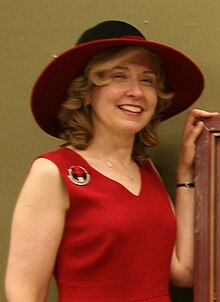
In the American magazine Pacific Standard, commentator Virginia Postrel asks "Who Killed Wikipedia?" (November 17). She details problems that have been plaguing the encyclopedia in recent years, beginning with the decline in the number of active editors. She notes that "Only about 3,000 editors contribute more than 100 changes a month to the English-language Wikipedia," whereas the number was about 4,700 in early 2007. She quotes a 2012 paper by Richard Jensen (User:Rjensen) as saying that Wikipedia is "operated by and for the benefit of the editors." She goes on to note that Wikipedia editors contribute to the site because they enjoy doing so, calling this "both the genius and the vulnerability of the organization." On the one hand, she says, Wikipedia's continued improvement is only possible because these volunteers are allowed to contribute to the site. On the other hand, Wikipedia's openness attracts a continuous stream of vandals and other types of unhelpful editors. This leads to the experienced contributors to the site becoming increasingly suspicious of new editors over time.
Postrel also interviews Dariusz Jemielniak and discusses his book Common Knowledge? An Ethnography of Wikipedia (see Signpost book review), which focuses on why Wikipedia's organizational design works despite the fact that, according to Jemielniak, it should not. Postrel describes Wikipedia's Five pillars, noting that the neutral point of view rule is accompanied by two other policies pertaining to content: original research and verifiability. She notes that some editors focus almost entirely on reverting vandalism and other edits that violate Wikipedia's guidelines, and praises Wikipedia's entry on George W. Bush as "remarkably detailed and dispassionate."
Postrel then tackles the issue of talk page discussions, where article content disputes are discussed, and notes that disputes only end when a given article is written in such a way that all editors are satisfied with it. She notes the existence of the policy advising against biting newcomers (WP:BITE), but nevertheless argues that Wikipedia, in practice, deters outsiders using "procedural knowledge and a sort of passive-aggressive resistance", and quotes Jensen as saying that activists don't put up with small mistakes when they have been editing for five or ten years. She also argues that experienced Wikipedians would have reverted some of the early edits made by celebrated editor Adrianne Wadewitz (User:Wadewitz). As evidence that Wikipedians are too hostile to new editors, she cites a study by Aaron Halfaker which found that less than 10% of "desirable newcomers" continued editing for at least two months in 2011, whereas in the first half of 2006, more than 25% did. She then points out that this is a problem because Wikipedia is not finished, and "many articles still fall short of encyclopedia quality."
She concludes by noting that Wikipedia has survived for twelve years or so, meaning that those who argued it would prove unsustainable relatively quickly have been wrong. But, she asks, "the perils of adolescence were one thing. What about middle age?"
Lawsuit filing reveals NCAA editing of Wikipedia

In 2012, the Penn State child sex abuse scandal resulted in the National Collegiate Athletic Association imposing sweeping penalties on Pennsylvania State University, including a $60 million fine. The penalties spawned a number of legal actions, including a lawsuit from Pennsylvania State Senator Jake Corman challenging the fine. Onward State, a independent Penn State student blog, reported (November 10) that court filings in that lawsuit include depositions and internal NCAA emails which reveal Wikipedia editing by the NCAA in regards to the Penn State scandal.
On December 13, 2012, NCAA President Mark Emmert emailed Bob Williams, NCAA Vice President of Communications, about his Wikipedia article: "Just saw that the Wikipedia site in [sic] me grossly misses the mark in describing the Penn State decision. Check it out and see how we put the record straight." Williams directed his staff to create new language for the article to replace material which he deemed "inaccurate" and "editorializing" in his testimony. An email from NCAA Web Director Ronnie Ramos proposed changes which match a December 17 edit to the article from an IP address belonging to the NCAA. The edit replaced this text:
| “ | As a result of increasing public pressure, Emmert bypassed key bylaws and procedures and forced Penn State University President Rodney Erickson, to either sign a consent decree accepting the sanctions or suffer the death penalty. [1] This action drew mixed reactions from the public, some of whom believed he overstepped his boundaries and did not provide Penn State the due process they believed was required. | ” |
with this, cited to the NCAA website:
| “ | The NCAA Division I Board of Directors and NCAA Executive Committee directed Emmert to examine the circumstances and determine appropriate action in consultation with these presidential bodies. Ed Ray, Executive Committee chair and Oregon State president, said that while there has been much speculation on whether the NCAA [2] had the authority to impose any type of penalty related to Penn State, the Executive Committee concluded the egregious behavior not only goes against NCAA rules and constitution but also against the NCAA's values. Because Penn State accepted the Freeh Report factual findings, which the university itself commissioned, the NCAA determined traditional investigative proceedings would be redundant and unnecessary. In making the announcement, Emmert said "We cannot look to NCAA history to determine how to handle circumstances so disturbing, shocking and disappointing." | ” |
Williams testified "And so, we routinely, now, routinely review Wikipedia and correct errors. Just like any other media."
The next day, Onward State reported on the vandalism that occurred on Emmert's article following the revelations, vandalism which Onward State seemed to applaud and encourage. The article was semi-protected for three days, but vandalism resumed following the expiration of the protection.
- ^ [1],
- ^ "NCAA levies sanctions". NCAA. Retrieved 17 December 2012.
Reader comments
The interesting world of urban planning
According to the WHO, 54% of the world's population now lives in urban areas. Chances are that you are one of them. Many Wikipedians contribute to articles relating to where they live or have visited. But have you ever thought a little beyond that and written about concepts of the cities, the towns, the areas themselves? If not, don't worry! There's a project for that, and it is the subject of the WikiProject Report this week. WikiProject Urban studies and planning, founded in 2006, has only around 30 members, but is perfectly active, with a rather wide scope looking the things that are in front of our eyes every day, yet so often overlooked. Topics encompassed include architectural conservation, city plans, environmental planning, ghost towns, slums, urban historians, historic preservation, the history of urban planning, land use, metropolitan areas, urban decay, neighborhoods, public housing, redevelopment, streets, urban agriculture, urban design, and zoning. It has to be said, that is rather a lot. We got the inside story by interviewing Dan arndt, Daniel Case and Elekhh.

What motivated you to join WikiProject Urban Studies & Planning? Do you work in this sector, or just have a keen interest?
- Dan arndt: I am a qualified planner and have worked in the field for over twenty years.
- Daniel Case: Primarily because I found myself writing about a lot of downtown and other urban historic districts for WikiProject U.S. National Register of Historic Places. As a journalist I had also covered planning issues in cities in New York and Ohio, so I had some of that experience already. I have also read some books in the genre, from older classics like Jane Jacobs' The Death and Life of Great American Cities and Joel Garreau's Edge City to newer ones like Donald Shoup's The High Cost of Free Parking and Charles Montgomery's Happy City. I guess you could say I'm an interested amateur.
- Elekhh: I studied and researched in this field and wanted to contribute to Wikipedia's coverage of these topics.

Can you explain precisely the scope of this project, and what things you do not cover?
- Dan arndt: The project is aiming to improve articles relating to urban and regional planning.
- Daniel Case: To use in-field terminology, I'd say it's about the built environment, the urban fabric. About what gets built, how, and why, and how it is used and how people interact with it.
- To give more specifics, I'd say its scope would include articles about:
- Not so much cities themselves (well, maybe extensively planned ones like Brasília would be exceptions) but ...
- well-established urban neighborhoods like Greenwich Village or St John's Wood,
- formal subdivisions of cities like not only the historic districts I have written about (such as the Central Troy Historic District (a GA of which I'm quite proud) here in upstate New York where I live) but the 16th arrondissement or the Dongcheng District of Beijing (an article which I expanded greatly after a visit there this past spring) and communities where planning and experimentation played a major role in their development like Chatham Village or Celebration;
- historic master plans for cities like the Commissioners' Plan of 1811 for Manhattan and the histories of cities themselves;
- books in the field like those I mentioned above (and others not strictly about urbanism but which have a lot to say about it, such as Robert Caro's The Power Broker); biographies of urbanists and planners like Baron Hausmann and, yes, Caro's subject Robert Moses;
- important historical movements in urban design such as the City Beautiful;
- government agencies with planning responsibilities and private organizations primarily focused on planning
- key laws such as the Urban Growth Boundary around Portland, Oregon, and court decisions such as Village of Euclid v. Ambler Realty Co. (which held zoning laws in the U.S. were constitutional).
- and terms and concepts within urban planning itself like green belt and zoning-ordinance terms like setback, pad site, variance—all words you may have had to learn when building, expanding or renovating a house or place of business—to the extent such terms can justify an encyclopedic article instead of a Wiktionary entry.
What would not be in the scope of this project? Articles about aspects of cities like mass transit systems, or particular buildings (except when, like Pruitt–Igoe or Unité d'Habitation, the building itself or its history has implications for the field as a whole), and articles about city government functions that, while planning may tie into it, are not generally planning-oriented, such as school districts or housing.
- To give more specifics, I'd say its scope would include articles about:

The project has 8 pieces of featured material and 26 good articles. Have you contributed to any of these articles? Are you currently working on bringing an article up to FA or GA status?
- Dan arndt: No, I haven't contributed to this projects FA or GA articles. I'm not currently working on bring an article to FA or GA status.
- Daniel Case: I have, as I've said, developed Central Troy Historic District (basically most of downtown Troy, New York) to GA status. While it began under the auspices of the NRHP project, I consider the history section of that article to be exemplary of what this project can bring—it tracks the development of downtown Troy over the past couple of centuries, how it was influenced by human decisionmaking and, most importantly, changing economic, social, and natural factors. If I get more information on the more recent history, how urban renewal and historic preservation faced off against each other during the 1970s, I think it could be an FA.

How do you fare gaining images for use within the project? Are there particular people who take photographs, or create diagrams and maps?
- Dan arndt: I usually search Wikimedia Commons for images relating to articles I'm working on. I also take my own photographs and add them to Commons if I can't find a suitable image.
- Daniel Case: I generally take my own photographs, and sometimes supplement them with appropriately licensed images from Flickr. And sometimes there's pics on Commons that can be used.
- Elekhh: The difficulty with illustrating urban studies articles is that they would require maps, diagrams and good quality aerial photographs, all of which are difficult to obtain with a free license. Few years ago Fgrammen created some good illustrations, but the project needs much more of these.
Does the project collaborate with any other projects?
- Dan arndt: I'm not aware of other projects that this project collaborates.
- Daniel Case: Well, there aren't any deliberate collaborations. But look at how I came to be involved ... through WP:NRHP. There's also potential for a huge overlap from WikiProject Architecture and WikiProject Cities, of course.
- Elekhh: As Daniel mentioned above, the project is close in scope to WikiProject Architecture, as demonstrated by the fact that our German and French WikiProject counterparts cover both architecture and urban studies.
What are the project's most pressing needs? How can a new member help today?
- Dan arndt: To attract editors that are interested in working on creating and improving articles covered by the project.
- Dan answered the first part of the question to the point that it needs no elaboration. As for the second ... well, look through the articles within the project scope, and if you see anywhere you think you could contribute and would enjoy doing so, start editing! Daniel Case (talk) 02:49, 9 November 2014 (UTC)
- Elekhh: Improving the quality of top and high importance articles is what I see the most pressing need. Currently none of them are FA and less than five reached GA-quality.
Next week, we'll have our 2014 update with WikiProject Military History. Until then, why not do some digging of your own in the archive?
Reader comments
Interstellar traffic
It is a curious coincidence that the event often described as having belatedly begun the twentieth century (the First World War) and the one often thought to have prematurely ended it (the fall of the Berlin Wall) were both commemorated this week, as the latter's 25th anniversary coincided with the day to mark the former's ending (Armistice Day). The theme of beginnings and endings as one was further elaborated by the 100th anniversary of the war's start, which fell in July this year.
For the full top 25 list, see WP:TOP25. See this section for an explanation of any exclusions.
As prepared by Serendipodous, for the week of November 9 to 15, 2014, the 25 most popular articles on Wikipedia, as determined from the report of the most viewed pages, were:
Rank Article Class Views Image Notes 1 Interstellar (film) 
2,567,100 
The debate just won't stop. Is this a cosmic masterpiece on the level of its inspiration, 2001? Or an exposition-laden string of trite scifi concepts that fails to reach its own goals? The critics aren't sure (Interstellar has the lowest RT score of any Nolan film to date) and neither, it seems, is the public (the film has yet to break $100 million domestically in its second week, despite strong overseas grosses), but nothing brings views to Wikipedia like debate, and this movie remains Wikipedia's no 1 talking point for the second straight week, with views up 60%. 2 Thanksgiving 
1,626,523 
This beloved holiday has been very ill-used by Wikipedia viewers. Every year, when it comes around, immediately money-spinning spammers start flooding Wikipedia with fake views for this article, thus forcing us to remove what should be a perfectly acceptable annual addition to this list. But now the mobile fraction is high enough (about 5%) to suggest that, were it not being obviously pumped up, it would still appear somewhere in the top 25, though exactly where is an open question. So in the name of seasonal good cheer, I am pardoning this turkey. Is it not, after all, in the Thanksgiving spirit to be overstuffed? 3 Philae (spacecraft) 
1,462,564 
Well, it may not have achieved what it set out to do, but ESA's plucky fridge-sized lander still managed to send back enough cool pictures from its unique position on the surface of a comet this week to win the hearts of the public. And who knows? The comet it's riding is still approaching the Sun. Philae may yet wake up when its solar panels are tickled. 4 Berlin Wall 
1,223,551 
It's odd to think, for me at least, that a fair portion of the people reading this weren't even alive when this came down, 25 years ago this week. To be fair, I was just a kid at the time, and barely understood the significance of what was happening as it unfolded on cable news. And really, no one truly grasped the magnitude of the structural collapse this crumbling wall would trigger. 26 months later, the Soviet Union was gone, the Cold War was over and we were left struggling to grasp what kind of world would replace the one we were born into. It's fair to say we still don't know. 5 Marvel Cinematic Universe 
1,076,501 
Its mobile percentage is suspiciously low (2.85%), but it's only natural that people would be interested in Marvel Studios' announcement of the third and longest phase of its ongoing cinematic saga, which has so far spanned six years, ten films, $1.7 billion in budgets and $7.1 billion in revenues. With two more films to go in phase 2, and a whopping nine for phase 3, the slate's booked til 2019, and it will be interesting to see if Marvel's so-far successful formula of risk-taking and artistic commitment will hold until then. 6 Veterans Day 
803,419 
The eleventh day of the eleventh month, when peace was declared after the hell of World War I, has been recognised for decades as a time to remember the dead of war. In the US, it is known as Veterans Day, while in the Commonwealth, it is known as Remembrance Day (see below). This year's carried a special poignancy due to its coinciding with the centenary of the start of World War I. 7 Victor Zsasz 
746,943 One of the more disturbing villains in Batman's rogues' gallery (and that's saying a lot), Victor Zsasz is a serial killer who carves scars into his flesh for every successful kill. His story has been somewhat retconned for the new TV series Gotham where he has been recast as the pit bull for Carmine Falcone. Interest in this character spiked this week with the newest episode, the first since his introduction. 8 Myles Munroe 
661,095 A Bahamian Evangelical preacher who caused a ruckus with his opposition to gay rights earlier this year, and then capped it by dying in a plane crash this week. 9 Facebook 
651,716 A perennially popular article, as it is the second most popular website in the world, after Google. 10 Big Hero 6 (film) 
604,591 
The public seem to have taken to the first Disney/Marvel crossover, (an anime-inspired superhero comedy based on an obscure Marvel property) as it has so far made a respectable $110 million in 10 days and looks set to at least equal its ersatz predecessor, Wreck-It Ralph, at the box office.
Reader comments


